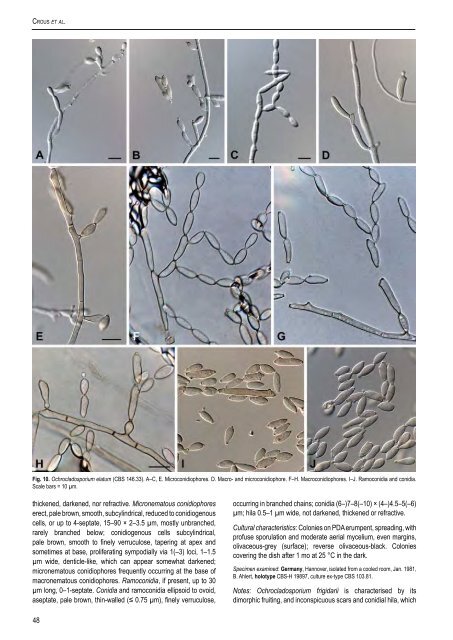The genus Cladosporium and similar dematiaceous ... - CBS - KNAW
The genus Cladosporium and similar dematiaceous ... - CBS - KNAW
The genus Cladosporium and similar dematiaceous ... - CBS - KNAW
Create successful ePaper yourself
Turn your PDF publications into a flip-book with our unique Google optimized e-Paper software.
Crous et al.<br />
Fig. 10. Ochrocladosporium elatum (<strong>CBS</strong> 146.33). A–C, E. Microconidiophores. D. Macro- <strong>and</strong> microconidiophore. F–H. Macroconidiophores. I–J. Ramoconidia <strong>and</strong> conidia.<br />
Scale bars = 10 µm.<br />
thickened, darkened, nor refractive. Micronematous conidiophores<br />
erect, pale brown, smooth, subcylindrical, reduced to conidiogenous<br />
cells, or up to 4-septate, 15–90 × 2–3.5 µm, mostly unbranched,<br />
rarely branched below; conidiogenous cells subcylindrical,<br />
pale brown, smooth to finely verruculose, tapering at apex <strong>and</strong><br />
sometimes at base, proliferating sympodially via 1(–3) loci, 1–1.5<br />
µm wide, denticle-like, which can appear somewhat darkened;<br />
micronematous conidiophores frequently occurring at the base of<br />
macronematous conidiophores. Ramoconidia, if present, up to 30<br />
µm long, 0–1-septate. Conidia <strong>and</strong> ramoconidia ellipsoid to ovoid,<br />
aseptate, pale brown, thin-walled (≤ 0.75 µm), finely verruculose,<br />
occurring in branched chains; conidia (6–)7–8(–10) × (4–)4.5–5(–6)<br />
µm; hila 0.5–1 µm wide, not darkened, thickened or refractive.<br />
Cultural characteristics: Colonies on PDA erumpent, spreading, with<br />
profuse sporulation <strong>and</strong> moderate aerial mycelium, even margins,<br />
olivaceous-grey (surface); reverse olivaceous-black. Colonies<br />
covering the dish after 1 mo at 25 °C in the dark.<br />
Specimen examined: Germany, Hannover, isolated from a cooled room, Jan. 1981,<br />
B. Ahlert, holotype <strong>CBS</strong>-H 19897, culture ex-type <strong>CBS</strong> 103.81.<br />
Notes: Ochrocladosporium frigidarii is characterised by its<br />
dimorphic fruiting, <strong>and</strong> inconspicuous scars <strong>and</strong> conidial hila, which<br />
48

















